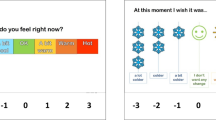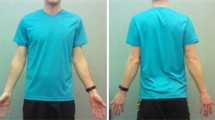Abstract
The head’s capacity for evaporative heat loss is important for design of protective helmets for use in hot environments. This study quantified head sweating rate (m sw) in eight males during rest and exercise at three metabolic rates (338 ± 36, 481 ± 24, 622 ± 28 W) in hot-dry (HD: 45 °C, 21 % RH) and hot-wet (HW: 35 °C, 69 % RH) conditions (matched at 31.6 °C WBGT), which were counterbalanced. Heads were shaved, and surface area was (458 ± 61 cm2) measured by 3D scanner. For measurement of head m sw, dry air was passed through a sealed helmet, whereas for forearm m sw a capsule (15.9 cm2) was ventilated with ambient air. Evaporation rate was determined from the increase in vapor pressure in the exiting air. Whole-body sweat loss was calculated from the change in nude weight plus fluid intake and corrected for respiratory fluid losses. Head m sw increased (p = 0.001) with metabolic rate, and was lower (p = 0.018) in HD (0.4 ± 0.2 mg cm−2 min−1 at rest to 1.1 ± 0.6 mg cm−2 min−1 at 622 W), compared to HW (0.5 ± 0.3–1.4 ± 0.8 mg cm−2 min−1). Forearm m sw increased (p < 0.001) with metabolic rate, but was higher (p = 0.002) in HD (0.4 ± 0.3–1.4 ± 0.7 mg cm−2 min−1) than HW (0.1 ± 0.1–1.1 ± 0.3 mg cm−2 min−1). Whole-body sweat loss was not significantly different (p = 0.06) between HD (647 ± 139 g m−2 h−1) and HW (528 ± 189 g m−2 h−1). This study demonstrates the importance of the head for evaporative heat loss, particularly for populations who wear protective clothing which can impair vapor transfer from the skin.



Similar content being viewed by others
References
Berglund LG, Gonzalez RR (1977) Evaporation of sweat from sedentary man in humid environments. J Appl Physiol 42:767–772
Bogerd CP, Brühwiler PA (2008) The role of head tilt, hair and wind speed on forced convective heat loss through full-face motorcycle helmets: a thermal manikin study. Int J Indus Ergon 38:346–353
Borg G (1970) Perceived exertion as an indicator of somatic stress. Scand J Rehab Med 2:92–98
Brengelmann GL, McKeag M, Rowell LB (1975) Use of dew-point detection for quantitative measurement of sweating rate. J Appl Physiol 39:498–500
Cabanac M, Brinnel H (1988) Beards, baldness, and sweat secretion. Eur J Appl Physiol 58:39–46
Candas V, Libert JP, Vogt JJ (1979) Human skin wettedness and evaporative efficiency of sweating. J Appl Physiol 46:522–528
Chinevere TD, Cadarette BS, Goodman DA, Ely BR, Cheuvront SN, Sawka MN (2008) Efficacy of body ventilation system for reducing strain in warm and hot climates. Eur J Appl Physiol 103:307–314
Coleman AE, Mortagy AK (1973) Ambient head temperature and football helmet design. Med Sci Sports 5:204–208
Consolazio CF, Johnson RE, Pecora LJ (1963) The computation of metabolic balances. Physiological measurements of metabolic functions in man. McGraw-Hill, New York, pp 313–339
Cotter JD, Patterson MJ, Taylor NAS (1995) The topography of eccrine sweating in humans during exercise. Eur J Appl Physiol 71:549–554
Egglestone GT, Robinson DJ (1999) Venting of a ballistic helmet in an attempt to reduce thermal loading. DSTO Aeronautical and Maritime Research Laboratory. DSTO-TR-0836, Melbourne
Gagge AP, Stolwijk JAJ, Hardy JD (1967) Comfort and thermal sensations and associated physiological responses at various ambient temperatures. Environ Res 1:1–20
Gonzalez RR, Pandolf KB, Gagge AP (1974) Heat acclimation and decline in sweating during humidity transients. J Appl Physiol 36:419–425
Havenith G, Fogarty AL, Bartlett R, Smith CJ, Ventenat V (2008) Male and female upper body sweat distribution during running measured with technical absorbents. Eur J Appl Physiol 104:245–255
Hsu Y-L, Tai C-Y, Chen T-C (2000) Improving thermal properties of industrial safety helmets. Int J Indus Ergon 26:109–117
Kissen AT, Summers WC, Buehring WJ, Alexander M, Smedley DC (1976) Head and neck cooling by air, water, or air plus water in hyperthermia. Aviat Space Environ Med 47:265–271
Kondo N, Takano S, Aoki K, Shibasaki M, Tominaga H, Inoue Y (1998) Regional differences in the effect of exercise intensity on thermoregulatory sweating and cutaneous vasodilation. Acta Physiol Scand 164:71–78
Kuno Y (1956) Human perspiration. Charles C Thomas, Springfield
Liu X, Holmér I (1995) Evaporative heat transfer characteristics of industrial safety helmets. Appl Ergonom 26:135–140
Machado-Moreira CA, Smith FM, van den Heuvel AMJ, Mekjavic IB, Taylor NAS (2008a) Sweat secretion from the torso during passively induced and exercise-related hyperthermia. Eur J Appl Physiol 104:265–270
Machado-Moreira CA, Wilmink F, Meijer A, Mekjavic IB, Taylor NAS (2008b) Local differences in sweat secretion from the head. Eur J Appl Physiol 104:257–264
Mello RP, Murphy MM, Vogel JA (1988) Relationship between a two mile run for time and maximal oxygen uptake. J Appl Sport Sci Res 2:9–12
Moran DS, Shitzer A, Pandolf KB (1998) A physiological strain index to evaluate heat stress. Am J Physiol 275:R854–R860
Nadel ER, Mitchell JW, Stolwijk JAJ (1971) Control of local and total sweating during exercise transients. Int J Biometeorol 15:201–206
Nakamura M, Yoda T, Crawshaw LI, Yasuhara S, Saito Y, Kasuga M, Nagashima K, Kanosue K (2008) Regional differences in temperature sensation and thermal comfort in humans. J Appl Physiol 105:1897–1906
Park SJ, Tamura T (1992) Distribution of evaporation rate on human body surface. Ann Physiol Anthrop 11:593–609
Patterson MJ, Stocks JM, Taylor NAS (2004) Humid heat acclimation does not elicit a preferential sweat redistribution toward the limbs. Am J Physiol 286:R512–R518
Ramanathan NL (1964) A new weighting system for mean surface temperature of the human body. J Appl Physiol 19:531–533
Randall WC (1946) Quantitation and regional distribution of sweat glands in man. J Clin Invest 25:761–767
Smith CJ, Havenith G (2011) Body mapping of sweating patterns in male athletes in mild exercise-induced hyperthermia. Eur J Appl Physiol 111:1391–1404
Smolander J, Ilmarinen R, Korhonen O, Pyykkö I (1987) Circulatory and thermal responses of men with different training status to prolonged physical work in dry and humid heat. Scand J Work Environ Health 13:37–46
Takano S, Kondo N, Shibasaki M, Aoki K, Inoue Y, Iwata A (1996) The influence of work loads on regional differences in sweating rates. Jpn J Physiol 46:183–186
Van Brecht A, Nuyttens D, Aerts JM, Quanten S, De Bruyne G, Berckmans D (2008) Quantification of ventilation characteristics of a helmet. Appl Ergon 39:332–341
Vokac Z, Køpke V, Keül P (1973) Assessment and analysis of the bellows ventilation of clothing. Textile Res J 73:474–482
Wenger CB (1972) Heat of evaporation of sweat: thermodynamic considerations. J Appl Physiol 32:456–459
Young AJ, Sawka MN, Epstein Y, Decristofano B, Pandolf KB (1987) Cooling different body surfaces during upper and lower body exercise. J Appl Physiol 63:1218–1223
Acknowledgments
We are very grateful to the subjects who cheerfully completed many days of exercise –heat stress. We are also indebted to the following people who assisted us with their technical expertise and ensured the success of this study: Larry G. Berglund, Jeremy Carson, Brian Corner, Leonard D. Elliott, Vincent A. Forte, SPC Robert E. Hollins, Peng Li, Ingrid V. Sils.
Conflict of interest
The authors declare they have no conflict of interest.
Author information
Authors and Affiliations
Corresponding author
Additional information
Communicated by George Havenith.
The opinions or assertions contained herein are the private views of the author(s) and are not to be construed as official or as reflecting the views of the Army or the Department of Defense. Human subjects participated in these studies after giving their free and informed voluntary consent. The investigators have adhered to the policies for protection of human subjects as prescribed in Army Regulation 70-25, and the research was conducted in adherence with the provisions of 32 CFR Part 219. Any citations of commercial organizations and trade names in this report do not constitute an official Department of the Army endorsement of approval of the products or services of these organizations.
Rights and permissions
About this article
Cite this article
O’Brien, C., Cadarette, B.S. Quantification of head sweating during rest and exercise in the heat. Eur J Appl Physiol 113, 735–741 (2013). https://doi.org/10.1007/s00421-012-2482-x
Received:
Accepted:
Published:
Issue Date:
DOI: https://doi.org/10.1007/s00421-012-2482-x




